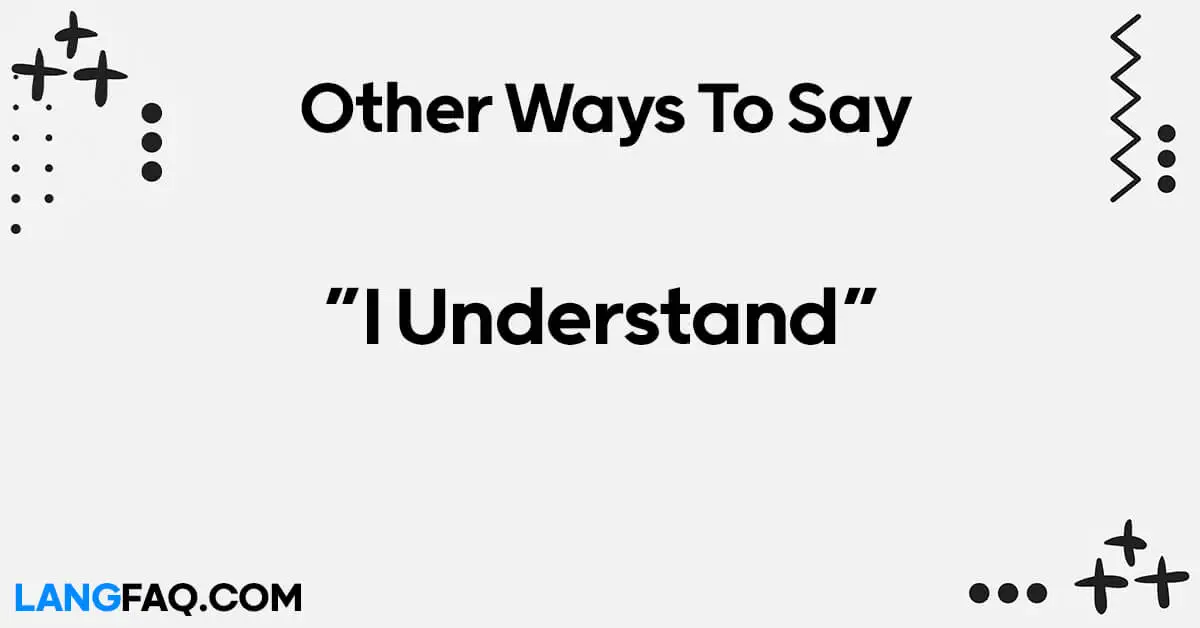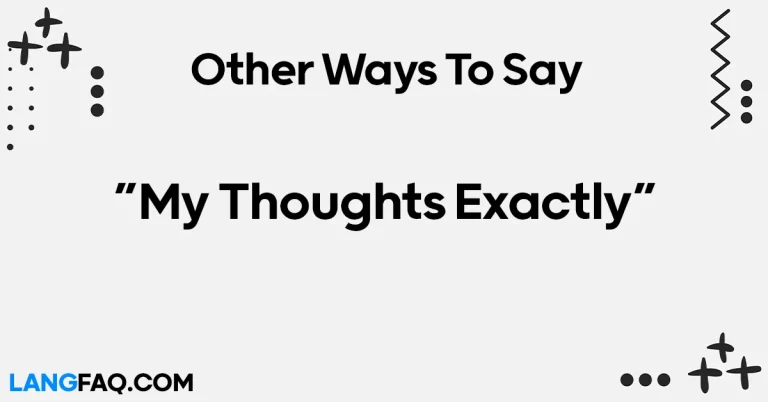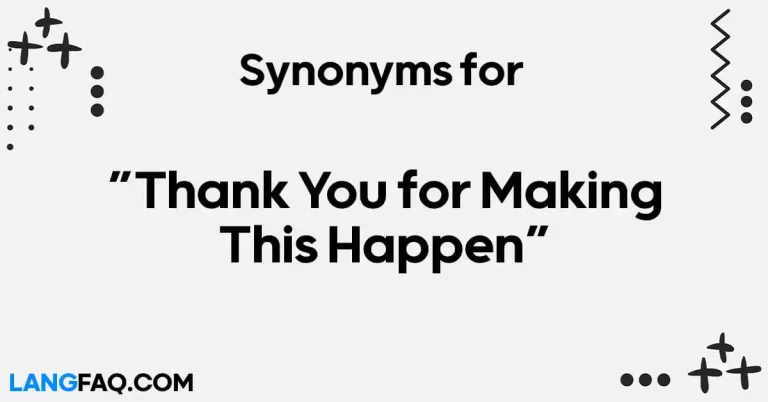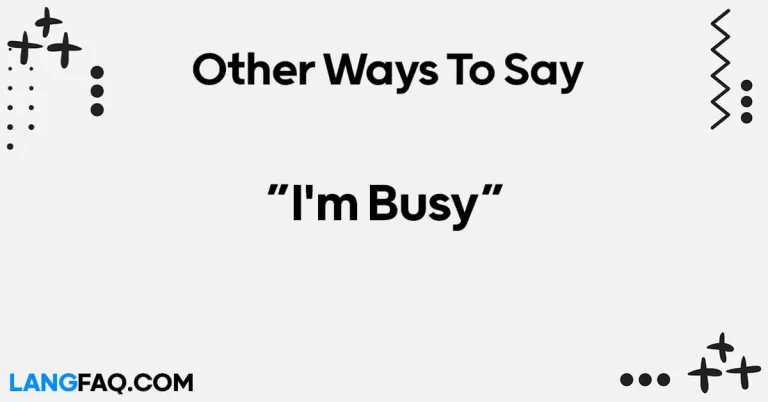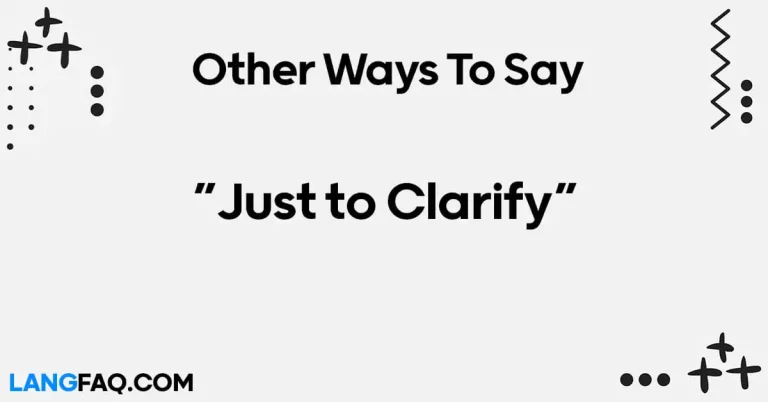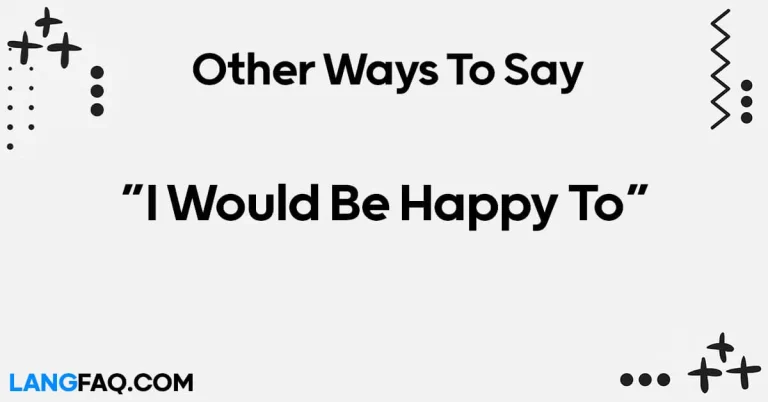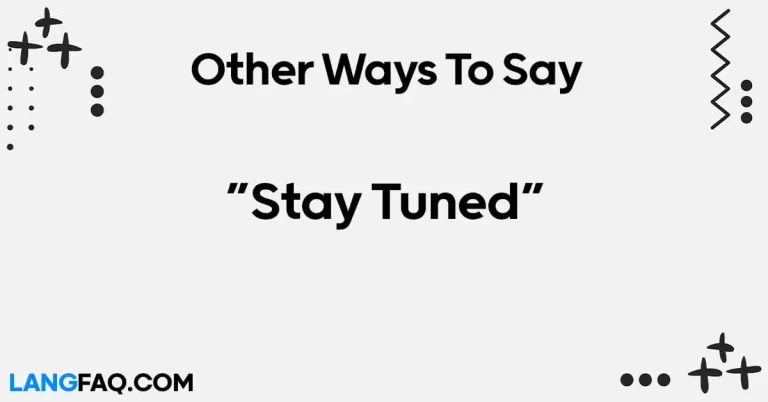Communication is the cornerstone of human interaction, and expressing understanding is crucial for effective communication. While the phrase “I understand” is commonly used, diversifying your vocabulary can significantly enhance your ability to convey empathy, comprehension, and connection. In this article, we’ll explore 12 alternative phrases to express “I understand” that are both expressive and impactful.
12 Other Ways to Say “I Understand”
Here are 12 other ways to say “I understand”:
- “I see where you’re coming from.”
- “That makes sense to me.”
- “I grasp the concept.”
- “I comprehend your point.”
- “I get it now.”
- “I’m following you.”
- “That’s clear to me.”
- “I’m on the same wavelength.”
- “It’s crystal clear.”
- “I’m with you on that.”
- “I’m picking up what you’re putting down.”
- “I’m tracking with you.”
Here’s a table with meanings and examples of 12 other ways to say “I understand”:
| Alternative Phrase | Meaning | Example |
|---|---|---|
| I see where you’re coming from. | I understand your perspective. | “I see where you’re coming from, but I have a different opinion.” |
| That makes sense to me. | I find it logical or understandable. | “Your explanation makes sense to me now.” |
| I grasp the concept. | I understand the idea or concept. | “After studying it further, I finally grasp the concept.” |
| I comprehend your point. | I understand your argument or viewpoint. | “I comprehend your point, and I agree with you.” |
| I get it now. | I now understand what you’re saying. | “Thanks for explaining it again; I get it now.” |
| I’m following you. | I understand and am keeping up with your explanation or conversation. | “Sorry for interrupting; please continue—I’m following you now.” |
| That’s clear to me. | I find it easy to understand. | “Your instructions are clear to me; I’ll proceed accordingly.” |
| I’m on the same wavelength. | I have the same understanding or opinion. | “I’m glad we’re on the same wavelength about this issue.” |
| It’s crystal clear. | It’s very clear and understandable. | “The instructions are crystal clear; I know what to do.” |
| I’m with you on that. | I agree with your viewpoint. | “I’m with you on that decision; it’s the right choice.” |
| I’m picking up what you’re putting down. | I understand the message or idea you’re conveying. | “I’m picking up what you’re putting down; your point is well taken.” |
| I’m tracking with you. | I understand and am following your explanation or instructions. | “Thanks for the detailed explanation; I’m tracking with you now.” |
These alternative phrases provide a diverse range of expressions to convey understanding effectively in various contexts, enriching communication and fostering better connections with others.
Is It Correct to Say “I Understand”?
Yes, it is correct to say “I understand.” This phrase is commonly used to indicate comprehension or acknowledgment of information, instructions, or someone else’s perspective. “I understand” can be employed in various contexts, including formal settings such as business meetings, academic discussions, or professional correspondence, as well as informal conversations with friends or family members.
“I understand” is a simple and straightforward way to communicate that you have grasped the content or message being conveyed. It shows that you are attentive and receptive to what is being said, and it can help facilitate smoother communication exchanges.
However, it’s important to note that while “I understand” is a valid expression, diversifying your vocabulary with alternative phrases can enhance your communication skills and convey empathy, agreement, or comprehension in a more nuanced manner. Utilizing variations such as “I see where you’re coming from,” “That makes sense to me,” or “I grasp the concept” can add depth and clarity to your interactions, depending on the context and tone of the conversation.
Professional Mail Example With “I Understand”
Subject: Confirmation of Project Details
Dear [Recipient’s Name],
I hope this email finds you well. I am writing to confirm our discussion earlier regarding the project specifications and deliverables.
After reviewing the documents and discussing the project requirements in detail, I want to reassure you that I understand the scope and objectives outlined for this project. I am fully committed to ensuring its successful completion within the agreed timeline and budget.
I understand the importance of adhering to the project milestones and maintaining open communication throughout the process. Rest assured, I will keep you updated on our progress and promptly address any concerns or adjustments that may arise.
Please feel free to reach out if you require any further clarification or if there are any changes to the project plan. I am here to support you every step of the way and ensure that we meet and exceed your expectations.
Thank you for entrusting me with this project. I look forward to our collaboration and the opportunity to deliver exceptional results.
Best regards,
[Your Name]
[Your Position]
[Your Contact Information]
“I See Where You’re Coming From”
Understanding another person’s perspective is key to effective communication and empathy. When you say “I see where you’re coming from,” you acknowledge that you understand their viewpoint or situation. This phrase can be used in both formal and informal contexts, making it versatile in various interactions.
Scenario: In a workplace meeting, a colleague expresses concerns about a proposed project timeline. You can respond with, “I see where you’re coming from. It’s important to ensure we have enough time for thorough planning and execution.”
Variations:
- Colleague to Colleague: “I understand your perspective.”
- Manager to Employee: “I appreciate your viewpoint on this matter.”
Example Sentence: Colleague: “I’m worried that the project deadline is too tight.” You: “I see where you’re coming from. Let’s discuss potential solutions together.”
Email Sample:
Subject: Re: Project Timeline Concerns
Hi [Colleague’s Name],
Thank you for bringing up your concerns regarding the project timeline. I see where you’re coming from, and I agree that it’s crucial to ensure we have enough time for proper planning and execution. Let’s schedule a meeting to discuss potential adjustments that can address these concerns.
Best regards, [Your Name]
“That Makes Sense to Me”
When someone presents an idea or explanation that is logical and understandable, you can respond with “That makes sense to me.” This phrase indicates that you comprehend the information presented and find it reasonable. It’s suitable for both professional and casual conversations.
Scenario: During a brainstorming session, a team member suggests a new approach to solving a problem. You can respond with, “That makes sense to me. Let’s explore that idea further.”
Variations:
- Friend to Friend: “I get where you’re coming from.”
- Teacher to Student: “Your explanation is clear and logical.”
Example Sentence: Team Member: “What if we try a different marketing strategy to reach our target audience?” You: “That makes sense to me. Let’s consider the potential benefits and drawbacks of that approach.”
Email Sample:
Subject: Re: New Marketing Strategy Proposal
Hi [Team Member’s Name],
Thank you for sharing your idea about the new marketing strategy. That makes sense to me, and I appreciate your creative thinking. Let’s schedule a meeting to discuss how we can implement this approach effectively.
Best regards, [Your Name]
“I Grasp the Concept”
When you fully understand a complex idea or concept, you can confidently say, “I grasp the concept.” This phrase indicates a thorough comprehension and can be used in educational, professional, or informal settings.
Scenario: During a training session, the instructor explains a new software feature. You can respond with, “I grasp the concept. Now, I just need to practice using it.”
Variations:
- Mentor to Mentee: “You seem to have grasped the concept quickly.”
- Student to Teacher: “I feel confident that I’ve grasped the concept after reviewing the material.”
Example Sentence: Instructor: “Does everyone understand how to use the new feature?” You: “Yes, I grasp the concept. I’m eager to try it out on my own.”
Email Sample:
Subject: Re: New Software Feature Training
Hi [Instructor’s Name],
Thank you for the comprehensive training session on the new software feature. I’m happy to report that I grasp the concept and feel confident in my ability to utilize it effectively. I appreciate your guidance throughout the session.
Best regards, [Your Name]
“I Comprehend Your Point”
Acknowledging someone’s argument or viewpoint is essential in communication. When you say, “I comprehend your point,” you demonstrate that you understand their perspective and are receptive to their ideas. This phrase is suitable for both formal discussions and casual conversations.
Scenario: During a debate, your opponent presents a compelling argument. You can respond with, “I comprehend your point, but I still believe there are valid counterarguments to consider.”
Variations:
- Colleague to Colleague: “I understand where you’re coming from.”
- Debater to Opponent: “I acknowledge your perspective on this issue.”
Example Sentence: Opponent: “I believe that implementing stricter regulations will solve the problem.” You: “I comprehend your point, but I think a more balanced approach is needed to address all aspects of the issue.”
Email Sample:
Subject: Re: Proposed Policy Changes Discussion
Hi [Opponent’s Name],
Thank you for sharing your insights during our discussion about the proposed policy changes. I comprehend your point regarding the need for stricter regulations, but I believe we should also consider alternative approaches to ensure comprehensive solutions. Let’s continue this conversation to explore all possibilities.
Best regards, [Your Name]
“I Get It Now”
When you finally understand something after struggling to grasp it, you can express your newfound understanding with “I get it now.” This phrase conveys a sense of relief and clarity and can be used in various contexts, from learning situations to everyday conversations.
Scenario: After struggling to understand a complicated math problem, your friend explains it in a simpler way. You can respond with, “Oh, I get it now! Thanks for breaking it down for me.”
Variations:
- Student to Tutor: “Thanks for your patience; I get it now.”
- Colleague to Colleague: “I finally get what you were saying earlier.”
Example Sentence: Friend: “Let me explain the concept one more time.” You: “Okay, go ahead.” Friend: “So, it’s like this…” You: “Ah, I get it now! That explanation really helped.”
Email Sample:
Subject: Re: Clarification on Project Requirements
Hi [Friend’s Name],
Thank you for taking the time to clarify the project requirements. Your explanation was extremely helpful, and I finally get it now. I appreciate your patience and willingness to assist me.
Best regards, [Your Name]
“I’m Following You”
When you’re actively listening and understanding someone’s explanation or instructions, you can assure them by saying, “I’m following you.” This phrase indicates that you’re engaged in the conversation and comprehending the information being conveyed.
Scenario: During a training session, the instructor demonstrates a complex procedure. You can reassure them by saying, “Don’t worry, I’m following you. Please continue.”
Variations:
- Mentor to Mentee: “Are you following me so far?”
- Friend to Friend: “Just to confirm, I’m following you—keep going.”
Example Sentence: Instructor: “Now, let’s move on to the next step.” You: “Wait, can you repeat the previous step? I want to make sure I’m following you correctly.”
Email Sample:
Subject: Re: Training Session Follow-Up
Hi [Instructor’s Name],
Thank you for the informative training session earlier today. I want to confirm that I’m following you on all the key points covered. Your explanations were clear, but if I have any questions later, I’ll be sure to reach out.
Best regards, [Your Name]
“That’s Clear to Me”
When you understand something with absolute clarity, you can affirm it by saying, “That’s clear to me.” This phrase indicates a complete comprehension and can be used in both formal and informal contexts.
Scenario: After receiving detailed instructions from your manager, you can respond with, “Thank you for explaining; that’s clear to me now. I’ll get started right away.”
Variations:
- Employee to Manager: “Your instructions are crystal clear.”
- Friend to Friend: “Thanks for explaining; it’s clear to me now.”
Example Sentence: Manager: “Do you have any questions about the project requirements?” You: “No, thank you. Everything is clear to me now. I’ll begin working on it immediately.”
Email Sample:
Subject: Re: Project Guidelines Clarification
Hi [Manager’s Name],
Thank you for clarifying the project guidelines during our meeting earlier today. I appreciate your thorough explanation, and everything is clear to me now. I’ll proceed with the tasks assigned according to your instructions.
Best regards, [Your Name]
“I’m on the Same Wavelength”
When you and someone else share the same understanding or perspective, you can express unity by saying, “I’m on the same wavelength.” This phrase emphasizes alignment and agreement, fostering a sense of camaraderie and mutual understanding.
Scenario: During a team discussion about a new project direction, a colleague proposes an innovative idea. You can respond with, “I’m on the same wavelength as you. Let’s explore this idea further.”
Variations:
- Colleague to Colleague: “I think we’re on the same page.”
- Friend to Friend: “I feel like we’re thinking alike on this.”
Example Sentence: Colleague: “What if we incorporate gamification into our project strategy?” You: “I’m on the same wavelength as you. Let’s discuss how we can implement this idea effectively.”
Email Sample:
Subject: Re: Project Strategy Alignment
Hi [Colleague’s Name],
I wanted to reach out regarding the project strategy discussion we had earlier. Your idea about incorporating gamification really resonated with me—I feel like we’re on the same wavelength. Let’s schedule a follow-up meeting to delve deeper into this approach.
Best regards, [Your Name]
“It’s Crystal Clear”
When something is incredibly easy to understand or perceive, you can emphasize its clarity by saying, “It’s crystal clear.” This phrase signifies a high level of comprehension and is often used to express certainty and confidence.
Scenario: After receiving training on a new software interface, you can reassure your instructor by saying, “Thanks for the demonstration; it’s crystal clear to me now. I’m confident I can use it effectively.”
Variations:
- Student to Teacher: “Your explanation made everything crystal clear.”
- Colleague to Colleague: “Thanks for clarifying; it’s crystal clear now.”
Example Sentence: Instructor: “Does everyone understand how to navigate the new system?” You: “Yes, thanks to your demonstration, it’s crystal clear to me now. I appreciate your thorough explanation.”
Email Sample:
Subject: Re: Software Training Recap
Hi [Instructor’s Name],
I wanted to thank you for the comprehensive training session on the new software interface. Your demonstration was incredibly helpful, and I’m happy to report that it’s crystal clear to me now. I’m confident in my ability to utilize the software effectively moving forward.
Best regards, [Your Name]
“I’m with You on That”
When you express agreement with someone’s viewpoint or decision, you can affirm your alignment by saying, “I’m with you on that.” This phrase conveys solidarity and support, reinforcing the bond between communicators.
Scenario: During a team meeting, your colleague suggests a new approach to resolving a project issue. You can respond with, “I’m with you on that. Let’s implement this solution and see how it goes.”
Variations:
- Friend to Friend: “Count me in; I’m with you on this.”
- Manager to Employee: “I support your decision; I’m with you on that.”
Example Sentence: Colleague: “I think we should allocate more resources to tackle the problem.” You: “I’m with you on that. Let’s discuss how we can reallocate resources to address the issue effectively.”
Email Sample:
Subject: Re: Resource Allocation Proposal
Hi [Colleague’s Name],
Thank you for presenting your proposal for reallocating resources to address the project issue. I’m with you on that, and I believe your suggestion could lead to significant improvements. Let’s proceed with implementing this solution and monitor the results closely.
Best regards, [Your Name]
“I’m Picking Up What You’re Putting Down”
When you understand and resonate with someone’s message or idea, you can express your comprehension with the colloquial phrase, “I’m picking up what you’re putting down.” This informal expression signifies understanding and alignment with the speaker’s intentions or message.
Scenario: During a brainstorming session, a colleague shares a creative concept for a marketing campaign. You can respond with, “I’m picking up what you’re putting down. That idea has great potential.”
Variations:
- Friend to Friend: “I understand where you’re coming from; I’m picking up what you’re putting down.”
- Mentor to Mentee: “Your insights are valuable; I’m picking up what you’re putting down.”
Example Sentence: Colleague: “What if we incorporate user-generated content into our campaign?” You: “I’m picking up what you’re putting down. Let’s explore how we can leverage user-generated content effectively.”
Email Sample:
Subject: Re: Marketing Campaign Brainstorming Ideas
Hi [Colleague’s Name],
Thank you for sharing your creative ideas during today’s brainstorming session. I just wanted to let you know that I’m picking up what you’re putting down—I believe your suggestion about user-generated content could really resonate with our audience. Let’s discuss this further in our next meeting.
Best regards, [Your Name]
“I’m Tracking with You”
When you’re following and comprehending someone’s explanation or instructions, you can affirm your understanding by saying, “I’m tracking with you.” This phrase indicates that you’re keeping pace with the speaker and grasping the information being conveyed.
Scenario: During a training session, the instructor provides step-by-step guidance on using a new software feature. You can reassure them by saying, “Don’t worry, I’m tracking with you. Please continue with the demonstration.”
Variations:
- Student to Teacher: “Just to confirm, I’m tracking with you on this topic.”
- Colleague to Colleague: “Thanks for clarifying; I’m tracking with you now.”
Example Sentence: Instructor: “Let’s move on to the next section.” You: “Wait, can you go back to the previous step? I want to make sure I’m tracking with you correctly.”
Email Sample:
Subject: Re: Software Training Follow-Up
Hi [Instructor’s Name],
I wanted to follow up on our software training session and express my appreciation for your clear instructions. I’m happy to report that I’m tracking with you on all the key points covered. If I encounter any challenges while practicing, I’ll be sure to reach out for assistance.
Best regards, [Your Name]
FAQs:
What’s the importance of diversifying phrases like “I understand”?
Diversifying phrases like “I understand” enhances communication by offering a range of expressions that convey empathy, agreement, and comprehension more effectively.
How can using alternative phrases improve communication?
Using alternative phrases fosters better connection and understanding between individuals, as it allows for more nuanced and empathetic communication tailored to specific situations.
Are these phrases suitable for both formal and informal contexts?
Yes, these phrases are versatile and can be used in various contexts, from casual conversations to professional settings, to express understanding and empathy.
Can body language play a role in conveying understanding?
Absolutely, nonverbal cues such as nodding, maintaining eye contact, and offering reassuring gestures can complement verbal expressions of understanding.
Why is empathy important in communication?
Empathy is crucial in communication as it allows individuals to understand others’ emotions, perspectives, and experiences, fostering deeper connections and mutual respect.
How can I practice incorporating these phrases into my communication?
Practice active listening and observe how others express understanding in different situations. Experiment with using these phrases authentically to enhance your communication skills.
Conclusion:
Expanding your vocabulary beyond the typical “I understand” can greatly enrich your communication skills and deepen your connections with others. By incorporating these 12 alternative phrases into your conversations, you’ll be better equipped to express empathy, agreement, and comprehension effectively across various contexts.

